Types of Yew Shrubs: Evergreens For Hedges, Privacy Screen, Foundation Planting and More (Pictures)

Yew shrubs are the most popular evergreen landscaping plants for hedges, privacy screens, foundation plantings, topiaries, and shrub borders. The dense, evergreen foliage of yews and tolerance of repeated pruning make them garden favorites. In addition, yew shrubs are typically low-maintenance plants that are tolerant of drought, they grow easily in most soil types and thrive in full sun or shade.
Yew bushes have a wide range of use in garden landscapes. For example, the popular hicks yew (Taxus x media ‘Hicksii’) is an upright, columnar evergreen, ideal for hedges. The Irish yew (Taxus baccata ‘Fastigiata’) is an upright yew, perfect for creating vertical interest. However, suppose you need a low-growing evergreen. In that case, the English yew (Taxus baccata ‘Repandens’) only grows around 3 ft. (1 m) tall but spreads up to 15 ft. (4.5 m) wide.
This article is a guide to finding the best types of yew shrubs for planting in your garden landscape. Descriptions and pictures of the most popular yew bushes will help you decide on which yews to grow.
About Yew Shrubs (Taxus)
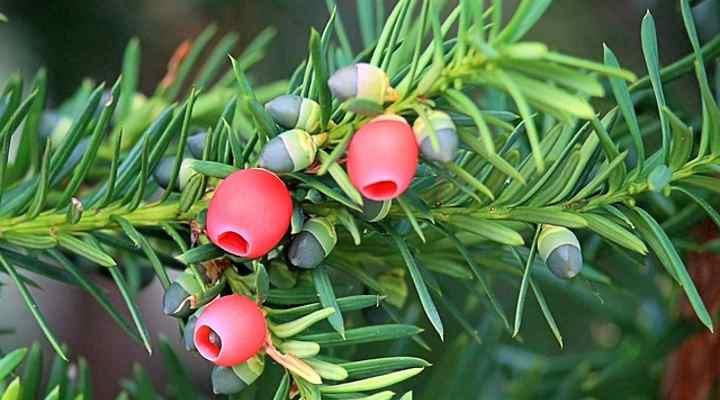
Yew leaves and mature and immature berry-like fruit called aril
Yew is a group of coniferous perennial shrubs and trees in the genus Taxus and family Taxaceae. Yew shrubs and trees differ from other types of conifers because they don’t produce the typical seed-bearing cones like pine trees, spruces, and cypress conifers. Instead, yew seeds are surrounded by a red fleshy structure called an aril.
Yew shrubs grow between 2 and 5 ft. (0.6 – 1.5 m) tall. With some taller yew shrubs, like the Hicks yew and Irish yew, regular pruning will help control their height. In addition, their dense foliage means that yews are ideal for creating box-like hedgerows in gardens.
Yew shrubs are identified by flat, needle-like leaves growing in two rows along stems. The yew leaves measure 0.4” to 1.5” (1 – 4 cm) long and 0.1” (3 mm) broad. Yew shrub leaves have a pronounced midrib that runs from the base to the point of the tip.
Yew shrubs also produce red, fleshy edible fruits. The rounded, cup-shaped arils are red to scarlet and appear from summer until fall. Although you can eat the fleshy part of the yew “berry,” the rest of the plant, including the seeds, are highly toxic.
Related reading: How to identify the most common yew trees.
Types of Yew Shrubs — Overview
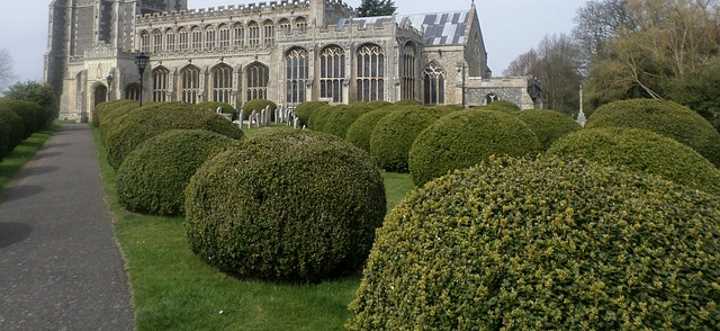
Yew shrubs love pruning and are great topiary plants
Here is a quick overview of the most common yew shrubs to add year-long greenery to a garden landscape:
Hicks Yew (Taxus x media ‘Hicksii’)—The Anglo-Japanese yew is an evergreen shrub with glossy dark green soft needles, dense foliage, and red fruits. Ideal for USDA zones 4 to 7, this popular hedgerow shrub grows 12 to 20 ft. (3.6 – 6 m) tall and up to 12 ft. (3.6 m) wide.
Irish Yew (Taxus baccata ‘Fastigiata’)—The most popular conifer in the world is the narrow, upright Irish yew. The columnar evergreen shrub grows 4 to 10 ft. (1.2 – 3 m) tall and 2 to 3 ft. (0.6 – 1 m) wide in ten years.
Japanese Yew ‘Densa’ (Taxus cuspidata ‘Densa’)—The Japanese spreading yew is a cold-hardy, dwarf shrub that reaches 4 ft. (1.2 m) high and 8 ft. (2.4 m) wide. The shrubby yew bush grows slowly and is suitable for USDA zones 4 to 7.
Canada Yew (Taxus canadensis)—The cold-hardy Canadian yew has dark green needle leaves that turn reddish-brown in winter. Suitable for USDA zones 3 to 7, the Canada yew grows 3 to 5 ft. (1 – 1.5 m) tall and up to 8 ft. (2.4 m) wide.
How to Care and Grow Yew Shrubs
To care for yew shrubs, grow the evergreen plants in well-drained, humus-rich soil that is kept evenly moist. Yew shrubs thrive in full sun to full shade and tolerate a range of soils. Use compost and evergreen shrub fertilizer in spring. Prune branches every springtime to promote bushy growth.
Pruning Yews
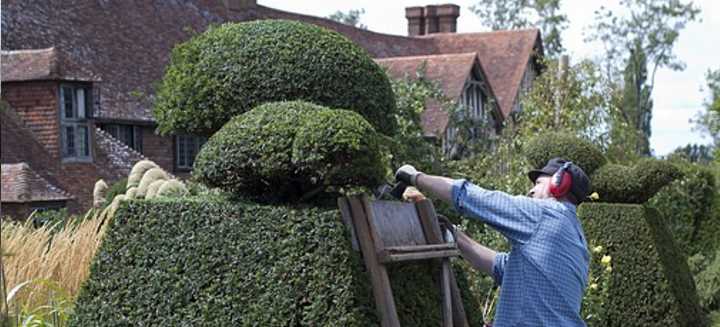
The best time to prune yew shrubs is in late winter or early spring before new growth starts
Prune yew shrubs in late winter or early spring before new growth appears. Cut off outer growth to encourage the shrub to be rounder or fuller. Also, look for branches growing back into the shrub and remove those. Avoid trimming the top of a yew until it has reached its desired height.
Unlike other conifers, yews sprout new growth on old wood. Therefore, even if you must severely prune a yew shrub, the plant will recover and continue to grow well.
To prune an overgrown yew shrub, you can trim back the leggy branches to the woody parts of the stem. Yews are hardy shrubs and can take hard pruning. For example, cutting back a yew to about 1 to 2 ft. (0.3 – 0.6 m) from the ground will help to rejuvenate the shrub.
Types of Yew Shrubs (With Pictures)
Let’s look in more detail at the most popular types of yew shrubs for garden landscapes.
Hicks Yew Shrub (Taxus x media ‘Hicksii’)

You can prune Hicks yew shrub to create a decorative living fence for privacy from neighbors
Hicks yew is a dense, evergreen shrub ideal for planting as a formal hedge, screen, or foundation plant. Hicks yew shrubs have a narrowly columnar habit with upward growing branches. The dense foliage consists of glossy green needle leaves that have a soft spine at the tip.
This fast-growing hybrid yew shrub is hardier than the Irish yew for hedging. You can grow a Hicks yew shrub in USDA zones 4 through 7. Like all yew shrubs, the Hicks variety grows just as well in the sun as in the shade. Hicks yew shrubs grow 12 to 20 ft. (3.6 – 6 m) tall and up to 12 ft. (3 m) wide.
To grow a Hicks yew evergreen hedge, privacy screen, or specimen plant, grow it in well-drained soil and keep the ground moist. However, once established, Hicks yew shrubs are relatively drought-tolerant plants.
Anglo-Japanese Yew (Taxus x media ‘Densiformis’)
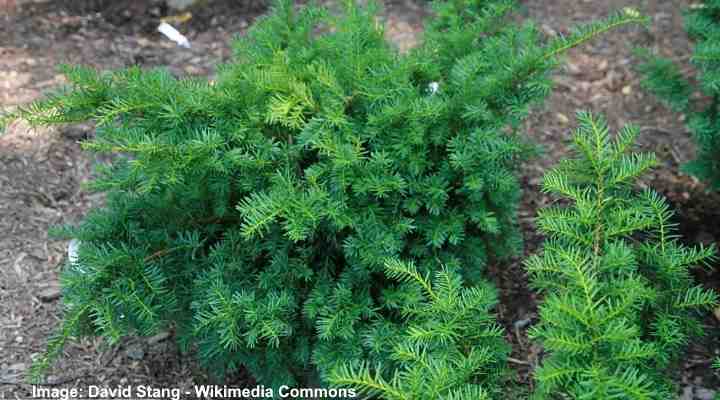
The spreading low growth habit of Taxus x media Densiformis makes it suitable as an evergreen ground cover plant
The Anglo-Japanese yew cultivar ‘Denisformis’ is a dwarf, evergreen shrub with a rounded habit and is popular as a foundation planting or low-growing hedge. The ‘Densiformis’ yew shrub also has a spreading habit, making it suitable for evergreen ground cover. Regular pruning encourages dense growth to create an attractive bush.
Anglo-Japanese yew ‘Densiformis’ grows 3 to 4 ft. (1 – 1.2 m) high and spreads up to 6 ft. (1.6 m) wide. Due to its short height and round form, the yew ‘Densiformis’ requires virtually no maintenance to grow well in landscapes. Suitable for USDA zones 4 to 7.
English Yew (Taxus baccata ‘Repandens’)
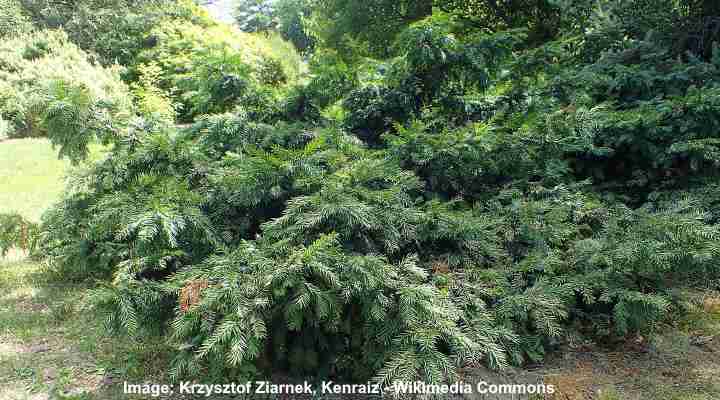
Taxus baccata ‘Repandens’ is an ornamental yew shrub that is suitable for both sun and shade
The English yew cultivar ‘Repandens’ is a low, spreading shrub perfect for foundation plantings, shaded ground cover, rock gardens, or shrub borders. The long branches will also droop over a wall. This popular small landscaping English yew shrub has dense foliage consisting of soft, flat needle-like glossy green leaves.
This spreading English yew grows 2 to 4 ft. (0.6 – 1.2 m) tall and up to 15 ft. (4.5 m) wide. The English yew ‘Repandens’ is suitable for sun or shade in USDA zones 6 to 8.
Dwarf English Yew Shrub (Taxus baccata ‘Repandens Aurea’)
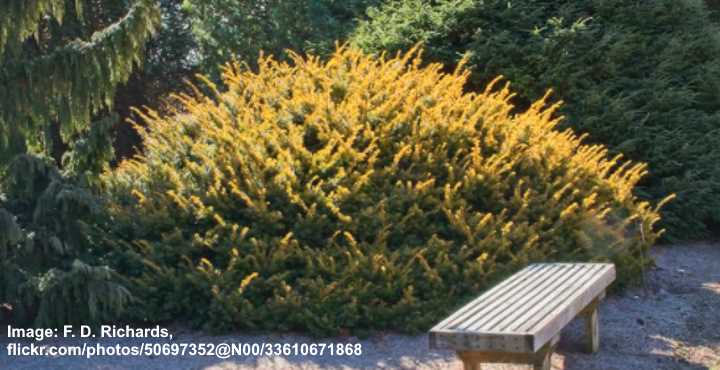
Dwarf English yew shrub has decorative yellowish-green foliage to brighten any garden landscape
The English yew ‘Repandens Aurea’ is a dwarf shrub that forms a mat of dense yellowish-green needle leaves. Growing 2 to 4 ft. (0.6 – 1.2 m) tall and 15 ft. (4.5 m) wide, the prostrate, spreading dwarf English yew is ideal for full sun ground cover, foundation plantings, or a specimen landscaping plant.
Irish Yew (Taxus baccata ‘Fastigiata’)
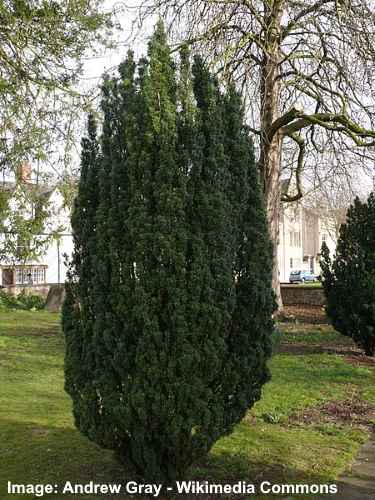
The columnar growth of Taxus baccata ‘Fastigiata’ will suit smaller spaces
The Irish yew is one of the world’s most popular conifers due to its upright, columnar growth, and low maintenance requirements. The narrow Irish yew shrub is perfect for planting to create a vertical accent, privacy screen, tall evergreen hedge, or foundation planting. The Irish yew is a moderate grower, growing around 1 ft. (30 cm) per year.
It takes about ten years for the Irish yew to reach 4 to 10 ft. (1.2 – 3 m) tall. Occasional pruning will help keep the yew shrub’s dense foliage at the required height. The Irish yew is cold-hardy to zone 6 and thrives in the sun or shade as long as the ground is moist.
Dwarf Bright Gold Japanese Yew (Taxus cuspidata ‘Bright Gold’)
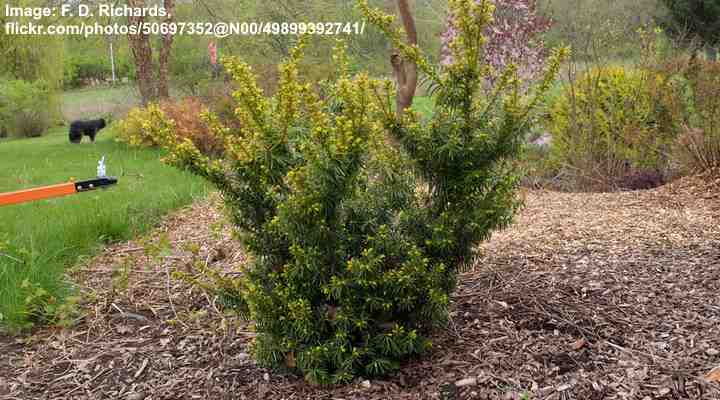
Taxus cuspidata ‘Bright Gold’ is a beautiful evergreen accent shrub with yellow-green foliage
The Japanese yew cultivar ‘Bright Gold’ is a dwarf conifer shrub that is excellent for foundation plantings, growing in containers or low-growing evergreen hedgerows. The Japanese yew has a spreading branching habit that develops as a mound with golden yellow and green needle leaves.
The dwarf spreading conifer ‘Bright Gold’ grows 4 to 6 ft. (1.2 – 1.8 m) tall and up to 7 ft. (2.1 m) wide. To get the best yellow-green color from this dwarf shrubby yew, grow it in partial shade. Partially shady conditions prevent the foliage from being bright yellow or dark green.
American Yew / Canada Yew (Taxus canadensis)
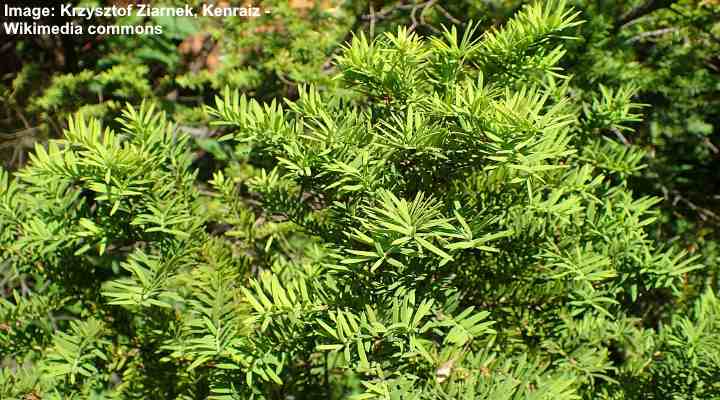
The cold hardy American/Canada yew doesn’t require much care and is a slow grower adaptable shrub
The Canadian yew is a shade-loving, sprawling shrub that is dense and suitable for a medium-sized evergreen screen, ground cover, or growing in front of the house. The upright, spreading branching gives the slow-growing Canadian yew an unkempt, shaggy look. Also called the American yew, this cold-hardy shrub thrives in USDA zones 3 to 7.
Comparing the types of evergreen yew shrubs, the Canadian yew is the least tolerant of full sun. In deep shade or partial shade, the yew grows 3 – 5 ft. (1 – 1.5 m) tall and up to 8 ft. (2.4 m) wide.
Citation Columnar Yew (Taxus x media ‘Citation’)
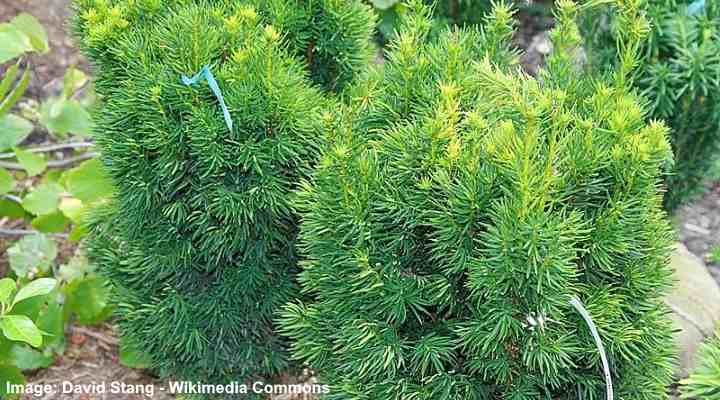
Young Taxus x media ‘Citation’ shrubs
The yew hybrid Taxus x media ‘Citation’ is a compact, upright, columnar yew perfect for a tall hedge or privacy screen. The ‘Citation’ yew grows multiple, upright stems with densely growing needles in a spiral arrangement. The ornamental hedging plant tolerates pruning at any time to encourage bushy, dense foliage.
The ‘Citation’ yew is a versatile landscaping shrub that thrives in USDA zones 4 to 7 in full sun to deep shade. The low-maintenance, upright shrub grows 6 to 10 ft. (1.8 – 3 m) tall and 3 to 6 ft. (1 – 1.8 m) wide.
Viridis Yew (Taxus x media ‘Viridis’)
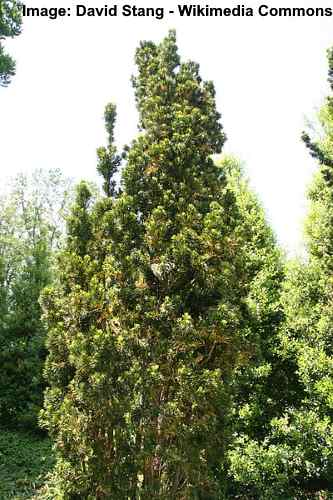
The conical shape of the slow-growing Viridis yew shrub makes is an excellent vertical accent plant
The hybrid yew Taxus x media ‘Viridis’ is a narrow evergreen yew shrub with a pyramidal growth habit. The attractive shape of this conical yew shrub makes it ideal as a specimen plant for a vertical accent. In addition, its narrow columnar growth and dense yellow-green to dark green foliage make it suitable for hedges, mass plantings, or privacy screening.
The ‘Viridis’ yew has a slow growth rate and grows up to 10 ft. (3 m) tall and with a spread of 2 to 4 ft. (0.6 – 1.2 m). Despite being a shade-tolerant evergreen, the yew shrub also thrives in full sun
Taxus x media ‘Green Mountain’
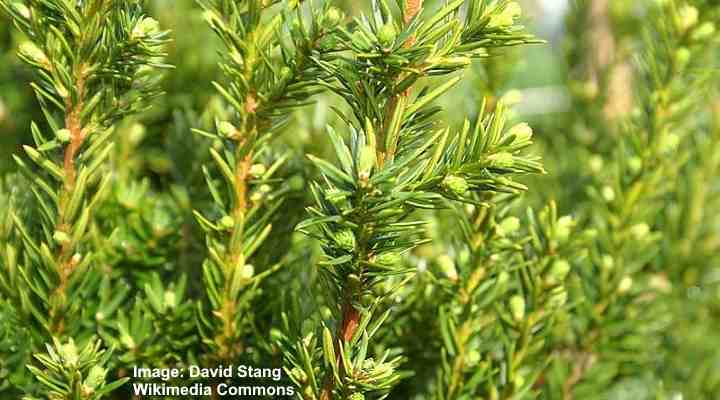
Taxus x media ‘Green Mountain’
Taxus x media ‘Green Mountain’ is a hybrid yew shrub with an upward spreading growth that forms a vase shape. The fast-growing, dark green yew is ideal for low- to medium-sized hedges, privacy screens, shrub borders, or foundation plantings. Thriving in full sun, the evergreen yew shrub grows up to 5 ft. (1.5 m) tall and 6 ft. (1.8 m) wide.
Flushing Yew (Taxus × media ‘Flushing’)
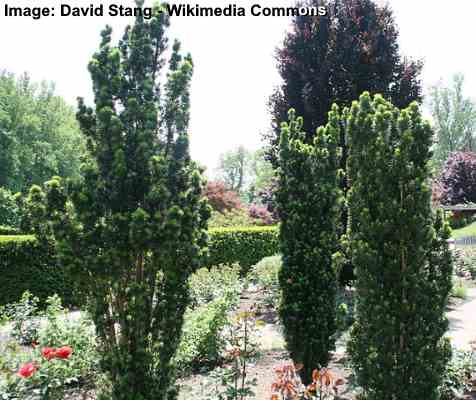
Taxus x media ‘Flushing’ is a narrow tall shrub suitable for compact gardens
The yew hybrid Taxus x media ‘Flushing’ is an exceptionally narrow, yew shrub with a pencil-like growth habit. The tall, narrow growth and dense needle foliage make the ‘Flushing’ yew an excellent choice for a thin, vertical accent in a landscape or corner of the house. A feature of the ‘Flushing’ yew is its fastigiated branches that grow parallel to the trunk.
The Taxus x media ‘Flushing’ yew shrub grows 12 to 15 ft. (3.6 – 4.5 m) tall and only 3 ft. (1 m) wide. Plant in well-drained soil, and this thin, columnar yew shrub will thrive in shade or sun in USDA zones 4 to 7.
Dwarf Japanese Yew (Taxus cuspidata var. nana)
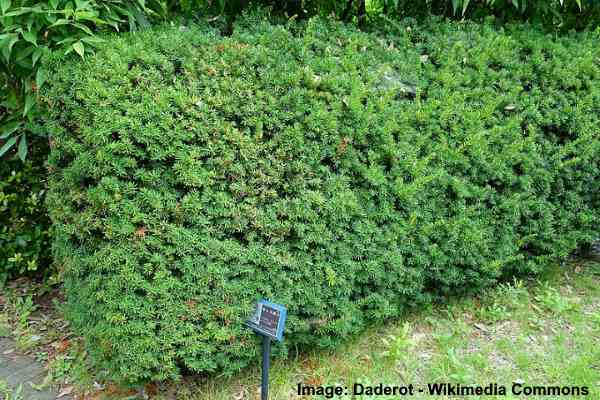
Dwarf Japanese yew can be pruned as a hedgerow shrub
The Japanese yew ‘Nana’ is a dwarf, evergreen shrub with compact, dense growth, dark green needles, and scarlet red fruits. Regular pruning will help keep the shrub’s lush appearance and regulate its height. Growing in full sun or part shade, the dwarf Japanese yew is ideal for planting as a privacy screen, hedgerow, or foundation planting.
The spreading dwarf Japanese yew ‘Nana’ grows 10 to 20 ft. (3 – 6 m) tall and up to 35 ft. (10 m) wide.
Japanese Yew Shrubs (Taxus cuspidata)
Japanese yew shrubs are popular in landscaping due to their low maintenance, excellent dense growth, and tolerance of poor soils. Japanese yews are also called the spreading yew due to their long, sprawling branching habits. Several types of Japanese yew are multi-stemmed shrubs and suitable for landscaping a front or backyard.
Taxus cuspidata ‘Capitata’
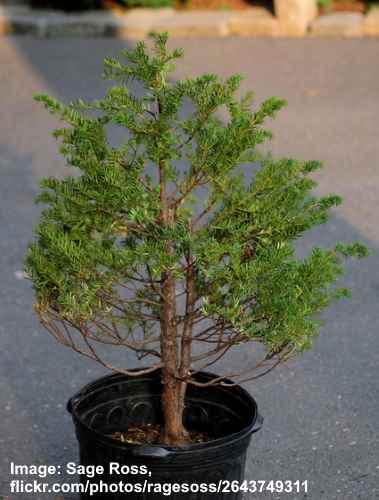
A young Taxus cuspidata Capitata shrub
The Japanese yew ‘Capitata’ is a medium-sized, spreading evergreen shrub with densely growing needle leaves on horizontal branches. The ‘Captitata’ Japanese yew has a pyramidal shape which looks attractive as a specimen plant. Additionally, you can also plant this spreading yew in mass plantings for a hedgerow or front-of-the-house planting.
The Japanese yew ‘Capitata’ thrives in shade or sun in USDA zones 4 to 7. It grows slowly, eventually maturing at 10 to 25 ft. (3 – 7.6 m) tall and 5 to 10 ft. (1.5 – 3 m) wide. Prune in spring to encourage dense, bushy foliage.
Other Japanese yew shrub cultivars include:
Taxus cuspidata ‘Columnaris’—The Japanese yew ‘Columnaris’ is a narrow, columnar shrub with a pyramidal shape. The slow-growing shrub grows 10 ft. (3 m) tall and 3 ft. (1 m) wide. Its narrow, vertical accent is ideal for growing as a specimen tree, hedge, or screen.
Golden Japanese yew (Taxus cuspidata ‘Aurescens’)—This slow-growing Japanese semi-dwarf multi-stemmed yew shrub has bright golden needle leaves. The spreading yew grows at a rate of 6” per year for the first ten years. It eventually grows 4 ft. (1.2 m) tall and 5 ft. (1.5 m) wide.
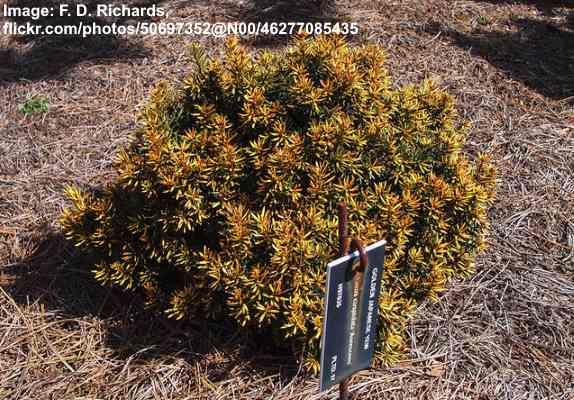
Golden Japanese yew (Taxus cuspidata ‘Aurescens’)
Dwarf Japanese yew (Taxus cuspidata ‘Nana Aurescens’)—One of the smallest yew shrubs is the ‘Nana Aurescens.’ This shade and sun-tolerant shrub grows 3 ft. (1 m) tall and 6 ft. (1.8m) wide. Grow this spreading yew as ground cover or in mass plantings as a shrub border.

Taxus cuspidata ‘Nana Aurescens’
Related articles:
